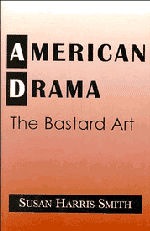Book contents
- Frontmatter
- Contents
- Acknowledgments
- 1 Introduction: The Problem of American Drama
- 2 Generic Hegemony: The Exclusion of American Drama
- 3 No Corner in Her Own House: What Is American About American Drama?
- 4 Did She Jump or Was She Pushed? American Drama in the University Curriculum
- 5 Caught in the Close Embrace: Sociology and Realism
- 6 Conclusion: Beyond Hegemony and Canonicity
- References
- Index
5 - Caught in the Close Embrace: Sociology and Realism
Published online by Cambridge University Press: 10 November 2009
- Frontmatter
- Contents
- Acknowledgments
- 1 Introduction: The Problem of American Drama
- 2 Generic Hegemony: The Exclusion of American Drama
- 3 No Corner in Her Own House: What Is American About American Drama?
- 4 Did She Jump or Was She Pushed? American Drama in the University Curriculum
- 5 Caught in the Close Embrace: Sociology and Realism
- 6 Conclusion: Beyond Hegemony and Canonicity
- References
- Index
Summary
In “american drama versus literature” (1938), Walter Prichard Eaton tackled the vexed issue of American drama's literary value by beginning with Homer E. Woodbridge's assessment of Quinn's Representative American Plays (1923) as “‘depressing.’” To Woodbridge's conclusion that “to get up much interest in the American theater before O'Neill one must consider it from the historical or sociological point of view,” Eaton quite sensibly asked, “Well, why not? Is it not perhaps true that in our study of the drama, certainly our academic study, we have put an emphasis on the literary side which neither the nature of the drama nor the function of the theater wholly warrants, and dismissed as unworthy of study much which, properly considered, is interesting and important? … Literary charm is an accident, or overtone, of drama, not its end. The end of drama is the emotional excitation of an audience in a theater” (“Drama” 81–82). If, Eaton asked, literary permanence depends on “romantic timelessness of theme” and on “a heightened speech which transcends its own hour,” how could the “realistic plays characteristic of our generation” survive (83)? Of course, in many literary histories and the canon such plays have not survived, and as a consequence a vital link between charged historical incidents and their dramatization has been obscured.
The very qualities that made modern drama powerful, its journalistic thrust and conversational vernacular, Eaton argued, ironically were the same characteristics that made it vulnerable: “The better [realistic plays] met the exacting test of realism, the slighter were their survival chances; … its vital appeal and its great creative dignity was its newly found technical ability to comment seriously on the contemporary scene, to be a weapon, consciously employed, of social criticism, and even of reform” (83).
- Type
- Chapter
- Information
- American DramaThe Bastard Art, pp. 159 - 196Publisher: Cambridge University PressPrint publication year: 1997

